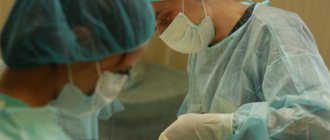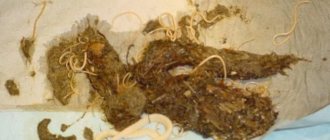The word “cryptorchidism” itself is understood as non-descent of the testis into the scrotum, due to its concealment by the groin or abdominal canal. Unilateral cryptorchidism in dogs is associated with the failure of one ovary to descend, but there are cases when both of them do not descend (bilateral cryptorchidism). How to recognize and treat the disease is described below.
General information
All dogs experience testicular descent at different times depending on the breed and individual characteristics. The testicle, emerging from the abdominal cavity, penetrates the inguinal canal and reaches the scrotum. Retention of the testis may occur in any part of the inguinal canal or at the posterior wall of the peritoneum.
Cryptorchidism is not immediately diagnosed in dogs. If the testis has not descended after two weeks from birth, it can be assumed that the animal is suffering from cryptorchid, but this will only be known for sure after six months, during the period of closure of the inguinal rings. It is worth noting that advanced cryptorchidism causes the dog to not participate in exhibitions, and also threatens the inability to have offspring.
Treatment
Various treatment methods are possible, but the condition of the testes influences the treatment options.
Therapeutic method can be treated if the testicles are easily palpable and the age does not exceed six months. In this case, some specialists prescribe massage and hormonal therapy.
Hormonal therapy is used if the level of special hormones responsible for prolapse of the testes is reduced. Such medications will help to cope with this problem if the cause is only hormones.
There is also a surgical method. Through surgery, the testis is lowered into the scrotum and secured there. This operation is prohibited almost everywhere, including Russia, due to the genetically inherited nature of the disease.
Castration. This operation is prescribed to remove the testes if no method has been effective, or if you initially decided to castrate your pet. If the animal develops complications or the veterinarian considers this measure necessary, then the operation is performed under general anesthesia and does not harm the animal’s body.
Causes
This disease occurs in the case of:
- enlargement of the testis, which cannot pass into the opening of the canal;
- insufficient length of the spermatic cord, which prevents the testicle from descending;
- underdevelopment of the scrotum or narrowing of the inguinal canal.
In normal organ functioning, the testicles descend under the influence of a ligament, which functions through the production of hormones. In case of hormonal imbalance, the testes cannot move properly.
With normal hormonal background, an inflammatory process can develop, leading to the formation of cryptorchidism. Usually by the sixth month the clinical picture is clear, but sometimes prolapse occurs in one-year-old individuals.
The development of the disease can also occur during embryonic development. If a pregnant dog does not have enough vitamin A or folic acid, it can affect the offspring.
Testicular prolapse is more common in breeds such as lapdogs, dachshunds, boxers, and so on. They also have false cryptorchidism, when the testicle periodically enters the scrotum.
It is worth remembering that with unilateral cryptorchidism, the ability of individuals to leave offspring is halved. They try to avoid such dogs from happening, because abnormalities can be passed on to their offspring. The presence of hormonal imbalances in cryptorchid is also the reason why it is better for this individual not to reproduce, which is associated with the use of special drugs.
With bilateral pathology, dogs are considered sterile, because the temperature in the peritoneum differs from that necessary for proper spermatogenesis. Sexual desire remains the same in any form of the disease.
Complications of cryptorchidism
If timely treatment is not carried out, complications of cryptorchidism develop:
- Inhibition of spermatogenesis when thermal conditions change. The longer and higher the testicle is in the peritoneum, the more it is exposed to the negative influence of high temperatures, the more reproductive function suffers.
- Tumors of a malignant nature, the risk of which with testicular dystopia increases by 20–35 times due to temperature disturbances, and treatment does not affect these indicators. The most dangerous is testicular seminoma.
- Testicular torsion is characterized by severe pain due to impaired blood supply to the organ.
- Dysplastic-dystrophic processes.
- Underdevelopment of secondary sexual characteristics.
- Hypospadias is a congenital anomaly of the penis, characterized by the location of the external opening of the urethra not in its physiological place.
- If the testicles are localized in the groin, they may be injured or twisted.
- Inguinal, umbilical hernia, strangulated hernia is an acute surgical condition.
It has been established that dystopic testicles undergo degenerative changes even in the prenatal period. If there is no timely treatment for cryptorchidism, then hormonal dysfunction gradually develops, which manifests itself in obesity, lack of groin and pubic hair, slow growth of facial hair, and a high-pitched voice. Adult men develop impotence. In boys with unilateral dystopia, fertility is reduced, but reproductive function is generally preserved. With bilateral non-descent of the testicles, fertility and the possibility of becoming a father in the future are significantly reduced.
Complications of cryptorchidism
Symptoms
Usually the disease proceeds without causing any discomfort to the individual. There are symptoms that help determine the presence of the disease:
- absence of a testis in the scrotum during visual examination;
- when palpated, the scrotum appears empty;
- abnormal development of the penis often accompanies cryptorchid;
- abdominal pain may indicate that the spermatic cord is twisted;
- swelling and redness of the scrotum indicate inflammation;
- from the location of the defective testis, hair loss may occur;
- the external genitalia are darker in color.
Diagnosis is carried out using ultrasound. With it, the picture of the disease becomes more clear.
Why is it dangerous?
The danger of cryptorchidism lies in the fact that the testis, located inside the body, and not in the scrotum, is not in a suitable temperature environment . The natural temperature of the scrotum is lower than body temperature, so the testis located in the abdominal cavity is constantly overheated.
Because of this, irreversible changes occur in it, which can result in the appearance of a tumor on this organ in a male dog by the age of 5. The likelihood of such a neoplasm appearing in cryptorchids is an order of magnitude higher than in healthy animals. But even if a tumor does not appear, such dogs have problems with the quality and quantity of sperm , some may be sterile, others may have reduced libido. In addition, cryptorchidism is often combined with other developmental anomalies, for example, with umbilical and inguinal hernia, as well as joint pathologies.
Trying to cure or operate
For this disease, both therapeutic treatment and surgical intervention are possible.
When choosing treatment, you need to know that such an intervention will not harm the individual, because in addition to cryptorchidism, other undesirable processes may occur in the body. Treatment for cryptorchidism in dogs depends on the cause and can vary. It is important to determine the stage of development of the disease. In some cases, a conservative approach is possible.
Conservative treatment
During treatment, the therapist prescribes hormonal medications or massage. Massage should be carried out until the age of six months, then positive results are possible (about 20% are cured). When the testicle is in close proximity to the scrotum, massage has a positive effect on the organs. The more often the procedure is performed, the faster the prolapse occurs.
If the puppy has been prescribed hormonal medications, then most likely it will be choriogonadotropin. This remedy causes the production of luteotropic hormone, which sets the testes in motion. If the disease is not associated with hormonal imbalance, this type of treatment is inappropriate, because it can lead to other pathologies.
Plastic surgery
In addition, plastic surgery can be performed, which will lower the testicle into the scrotum, but will not affect reproductive ability in any way. This procedure will allow purebred dogs with a pedigree to be shown at exhibitions, but for aesthetic reasons, even with unilateral pathology, mating should not be performed.
In many respects, it is easier to remove the testes, but there is a small chance that, returning to their proper place, the testes restore reproductive function, but this has not been proven. In our country, doctors who carry out such surgical interventions are considered to be charlatans.
Treatment with castration
Treatment of cryptorchidism in dogs can be carried out in another way - castration. Depending on the type of pathology, the operation is performed from 15 minutes to an hour. If the testis is retained in the abdominal cavity, abdominal surgery will be required.
Prepare for it as follows:
- before castration, the animal is examined by a specialist;
- tests are taken: blood, urine, x-ray examination;
- a month before the procedure, the necessary vaccinations are given;
- in two weeks, helminths and organic parasites are removed;
- 24 hours before the procedure, bathing is performed;
- restriction on food intake within 12 hours and liquid intake within five to six hours.
After the doctor carries out the necessary procedures, the castrated male comes to his senses. How quickly this happens depends on many factors:
- age of the individual;
- length of the procedure;
- degree of obesity;
- characteristics of the drugs used.
Complete withdrawal of painkillers can take up to 12 hours. Once the cryptorchid has been neutered, the animal can be moved to a hospital, but this is usually not necessary and the animal is taken away to be cared for at home.
The seam must be carefully monitored and treated with antiseptic agents prescribed by the veterinarian. Most often these are sprays, ointments and solutions. For acute pain, the necessary medications are prescribed.
To prevent the seam from becoming dirty or damaged, the dog must wear a special protective blanket. It is important to observe all this, because the consequences can be disappointing. After two weeks, the stitches are removed.
It is important to monitor the animal after anesthesia. If breathing is intermittent, and the mucous membranes have taken on an unnatural shade, this is a cause for concern and needs to be treated.
Normally, urination and defecation occur no earlier than every other day. The temperature does not rise above 39 degrees, and vomiting occurs no more than twice during the entire period. After a few hours, the animal again experiences a normal appetite for the body, and a day later activity is restored.
Clinical guidelines (European Association of Urology)
- Children with an increased cremasteric reflex (retractile testicles) do not require medical or surgical treatment, but they require regular monitoring until puberty;
- the optimal timing of treatment if cryptorchidism has developed is from 6 to 18 months of the child’s life;
- for non-palpable testicles, laparoscopy is the “gold standard”, since it has almost 100% sensitivity and specificity for identifying intra-abdominal testicles, allowing simultaneous surgical correction;
- adjuvant and non-adjuvant hormonal therapy is not standard treatment. Its use must be individualized for each patient;
- in the presence of an intra-abdominal testicle on one side and a normal contralateral testicle in children over 10 years of age, it is advisable to remove the intra-abdominal testicle due to the high risk of malignancy.
- Federal clinical guidelines “Cryptorchidism”
- Pediatric urology-andrology: Textbook. allowance. — Razin M.P., Galkin V.N., Sukhikh N.K.
- Algorithm for the treatment of children with cryptorchidism Al-Mashat N.A., Kovarsky S.L., Petrukhina Yu.V.
- Surgical treatment of cryptorchidism in children Zholumbaev A.O., Raselbaev K.U.
Prevention
Since it is almost impossible to predict the development of the disease before the birth of an individual, a preventive measure is the availability of a complete, balanced diet for a pregnant dog. Her diet should be full of elements necessary for the development of puppies. This is especially important to observe in the last month of pregnancy.
A preventive measure is castration of puppies with pathology. In addition, it is necessary to breed a dog only with a full-fledged male in order to exclude the possibility of the birth of defective individuals.
Progress of the operation
Let us consider the progress of orchiectomy in a specific case. The patient is a male, 7 years old, mixed breed. The left testis is cryptoroid - located intra-abdominally in the hypogastrium. A diagnosis was made of true unilateral cryptorchidism with intra-abdominal localization of the left testis. First, before the operation, premedication is performed and then the animal is put under anesthesia.
The first stage - preparation of the surgical field is carried out taking into account generally accepted rules of asepsis.
Rice. 1. Preparation of the surgical field.
The next stage is surgical access. Surgical access is carried out layer by layer, above the location of the testis. The dissected vessels are coagulated.
Rice. 2. Surgical access.
Rice. 3. Surgical access, coagulation of blood vessels.
Rice. 4. Opening of the abdominal cavity.
The next step is to remove the left (cryptorchoid) testis. As you can see, it is significantly enlarged, which indicates its neoplastic degeneration.
Rice. 5. Extraction of the cryptorchoid testis.
Then the testicular vein, artery and spermatic cord are ligated and dissected. The testis is removed.
Next, the wound is sutured in layers.
Rice. 6. Layer-by-layer suturing of the wound.
The last step is to remove the normal testis. This happens as during normal castration of a male dog.
Rice. 7. Surgical access to the right (healthy) testis.
Rice. 8. View of the right testis.
Rice. 9. The vessels and spermatic cord are ligated/coagulated and dissected.
Rice. 10. The testis is removed. The wound is sutured.
Rice. 11. View of the patient immediately after surgery.
Forecast
Usually the disease is cured quickly and no complications arise. After three weeks, the animal recovers and can return to its usual routine.
In some cases, complications are possible, but they occur rarely and are associated with the characteristics of the body or disturbances during the procedures (for example, contamination of the suture).
It is important to monitor your pet not only in connection with sterilization, but also at the slightest suspicion of a disease. It can affect more than one offspring, so why not just monitor the pet and provide the necessary assistance in a timely manner. With constant monitoring and care of the dog, no problems will arise.
Preoperative and postoperative care
To select a safe dose of anesthesia, a four-legged patient needs to undergo blood tests and have a cardiogram. During the postoperative period, the body's defenses are reduced, so before surgery, care should be taken for vaccination (20-30 days before) and antiparasitic treatment (10-14 days before).
You can wash the entire animal no later than one day before surgery. Water removes the protective layer, increasing the risk of infection in postoperative wounds.
You should also go on a fasting diet (12 hours before) and give up water (6 hours before). Otherwise, undigested food and water can cause vomiting, which can lead to aspiration pneumonia.
After waking up from anesthesia, the dog is returned to its owner. During the rehabilitation period you should:
- Take care to create a warm and comfortable place, protected from noise and other irritants.
- Strictly follow all doctor's recommendations for suture treatment.
- Avoid swimming before removing the suture material to avoid it getting wet and causing the wound to fester.
- Buy an Elizabethan collar or blanket that prevents wounds from licking.
- Avoid active games, long walks and contact with other animals.
If frequent vomiting, high fever, suspicious swelling, suppuration and other complications occur, you should consult a veterinarian. If the dog’s health is stable, then you should come for an examination only 2 weeks after the operation.











